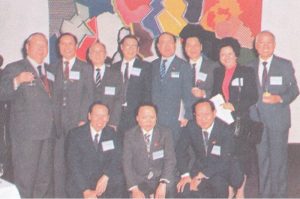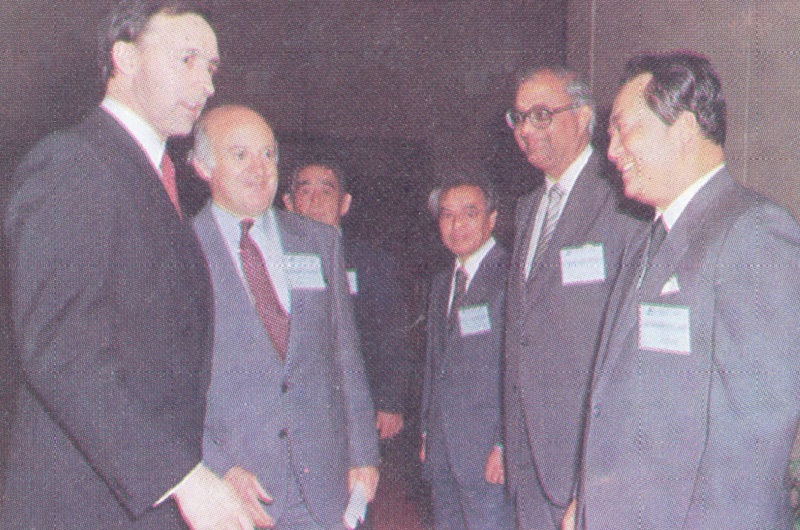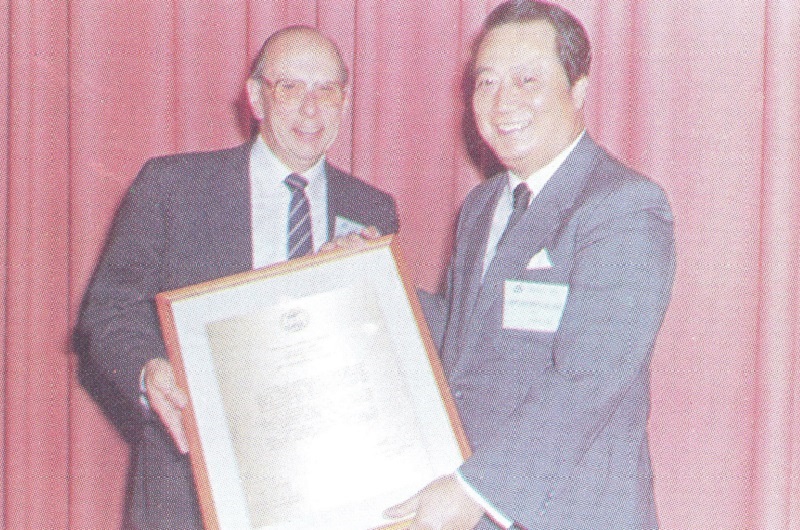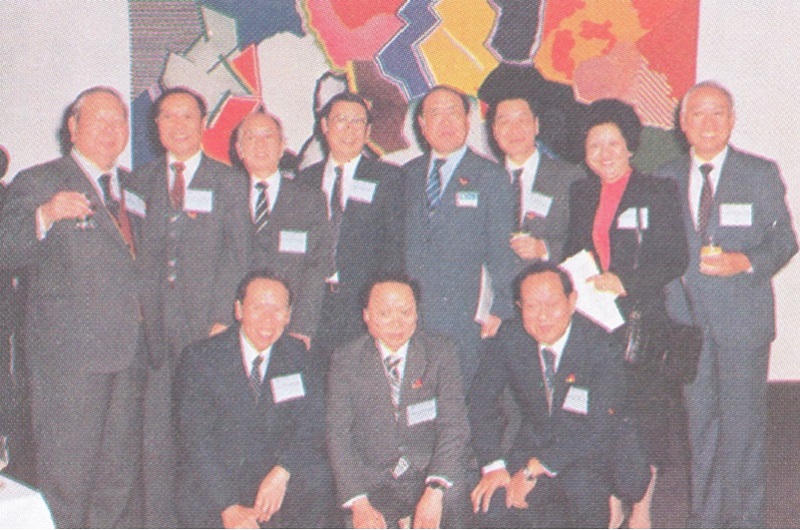New Financial Developments in the Asia-Pacific Region
12-15 November, 1984
SUMMARY OF PROCEEDINGS
OPPORTUNITIES AND RESPONSIBILITIES
Address By D.N. Sanders
Deputy Governor of Reserve Bank Of Australia
It is a pleasure to be here today for the opening of this second general meeting of the Asian Bankers’ Council. The Council is a young body and, speaking as one who Australia, have the opportunity to host a meeting so early in its life. I would like to congratulate Stuart Fowler on his appointment as Chairman of the Council for the next two years. I am sure that under his leadership this Council will grow on the foundations laid under the guidance of Ronald Ho, its outgoing Chairman and Jeffrey Koo, its founder.
This Council provides a forum in which bankers can gather to discuss ideas and mutual problems and to chart a way forward in a changing world. There is much happening in the financial markets of our dynamic region. It is an exciting and challenging time for banking in particular. The Asian region has, for some time, been the most rapidly growing in the world. Bankers can rightly take pride in their contribution which they have made to this impressive performance, by rewarding savers and financing sound projects.
More recently, banks have been taking advantage of the Asian time zone to build an important place for the region in international financing. This has been facilitated by technological advances, the so-called communications revolution which have drawn national financial markets closer together. In a similar way, expanding capacity for international trade in both gods and services draws national economies closer together. Developments in one of the major financial centres or major markets can be transmitted quickly around the globe. It has become increasingly difficult for any of us to swim against the current of world events.
For instance:
- we can all be buffeted by sharp movements in exchange rates or interest rates in the major centres;
- we all await with considerable interest the latest news on the U.S. Budget deficit or on OPEC pricing policy;
- We are all in some degree concerned with the global problem of debt servicing – as debtors or as creditors, or through our connection with debtors and creditors and our interest, as bankers, in the stability of the world financial system.
We seem to be increasingly susceptible to trends of various kinds in financial markets. Looking at financial markets in general, and banking in particular, over the past decade or so, I would think that probably the most distinctive feature has been the trend towards deregulation.
For instance, exchange rates are now much freer than they were previously to adjust to market forces: interest rates in many countries are now quite flexible: new financial instruments and financing arrangements are devised almost daily. Those who have to give substance to the theme for your conference – new developments in Asia Pacific financial markets – will not be short of material.
Another trend in recent years has been for a growing amount of international financial business to be conducted in centres where conditions, sometimes including taxes, are set to attract business from national financial markets. This trend could have interesting implications.
For example, taking a long view, if the trend were continued it could in time cause pressure to reduce taxes on domestic financing which might suffer from competition from international financing. This could, in time, have implications for the tax base and the structure of taxation. It is for governments to weight the gains against the losses involved in extending favoured treatment of this nature. From my central banker’s perspective there is another implication of such arrangements.
Some of those international markets are subject to little supervision or regulation and many lack a basis of financial support, such as access to a lender of last resort, from official agencies in whose area the markets lie. These markets rely on large wholesale deposits and they can be seriously and quickly disturbed by a change in fortune or, sometimes, even by the fast-moving rumour or the whisper of a crisis.
 Then, there can be very substantial withdrawals of fund from the institution concerned, even if that institution itself has clear recourse to the support of a very strong lender of last resort. Those banks withdrawing their funds obviously do not feel they can risk being denied access to them, much less suffer a loss.
Then, there can be very substantial withdrawals of fund from the institution concerned, even if that institution itself has clear recourse to the support of a very strong lender of last resort. Those banks withdrawing their funds obviously do not feel they can risk being denied access to them, much less suffer a loss.
Since they often do not have direct access to an official source of support in that foreign currency, they have to look to their own liquidity in the foreign currency concerned. In short, in such markets present-day bankers face the same sort of situations as the old-time bankers did and they need to develop their protective systems and instincts accordingly.
A banker’s home supervisors can take an interest in its operations in these markets, but the basic responsibility lies with the banker himself. The wholesale international banking markets are so efficient that it is easy for each participant to assume that their own small needs for renewal of funds positions can always be met. Wise bankers are reducing their dependence on these funds, by issuing longer term liabilities.
There is also closer assessment of the quality and liquidity of assets for the inherent limitations of liability management need to be remembered internationally as much as, if not more than, in domestic operations. This is just one aspect of the many responsibilities falling on bank management these days. Of course all opportunities carry responsibilities.
I understand that the Treasurer, Mr. Keating, will be telling you tomorrow about de-regulation in Australia. So I shall not traverse that ground in any detail. But I would like to talk briefly about some of the implications of de-regulation.
De-regulation in Australia has been pretty extensive. It is a process which has been going on for some years but it has accelerated dramatically recently. It covers many aspects of financing. Those lying within my own area of responsibility are:
- the de-regulation of banking, which has greatly improved the banks’ capacity to compete in the financial system;
- the dismantling of exchange control, which has given Australians new-found access to foreign capital markets for investments, etc. and made operations in Australian financial markets and investments easier for non-residents;
- the floating of the exchange rate, which has gone with a great expansion of the number of foreign exchange dealers from a dozen to fifty and given all who wish to exchange between $A and foreign currency a more competitive and responsive market;
- the introduction of a tender system for government securities which has made for much sounder debt management and for greater opportunities for bond dealing (which has led the Bank to change its own bond trading arrangements to encompass a wider range of dealers).
There have been other important developments in re-regulation or steps to improve efficiency in other parts of the financial system, which I shall not recount today. De-regulation offers many benefits, not just to those banks and others on whom regulation is lightened.
Markets which are less fettered by regulations and controls are better able to adapt quickly to changing circumstances. They are better able to enable investors and lenders to find projects which offer the highest rates of return commensurate with the degree of risk involved. Financial markets which are not subject to excessive regulation are, in principle best able to contribute to the growth and prosperity of the economies which they serve.
De-regulation in Australia has been occurring in a financial system which was, in many respects, already well-serviced and quite competitive in spirit. You need to understand that in Australia, setting aside such bodies as development banks, we have:
- 4 major banks which conduct substantial business in virtually all areas of domestic branch banking here and in some other near-by countries, and have a growing involvement in international banking;
- 4 banks owned by State governments, which are significant forces in banking in their own states and are developing wider interesting;
- four smaller banks some of which have more specialized interests, either in terms of particular types of banking or geographical area served.
Trading banks have $65 billion assets in Australia: savings banks A$38 billion. Then there are about 60 merchant banking groups. These merchant banks may have significant business in fee-paying areas such as corporate advice, portfolio management, etc. They also compete strongly with banks, mostly in the short-term market, and have total assets of about A$18 billion. There are around 130 finance companies with assets of $24 billion competing for household business financing.
There are 70-odd building societies with assets of $18 billion competing in the household finance field, lending predominantly for housing, and about 170 sizeable credit unions with about $4 billion of assets involved in personal financing. Viewed in the broad, this is quite a competitive scene. Although past regulation has limited access to some areas of financing, it has certainly not closed out competition altogether. An innovatory spirit has ensured that competition has been sustained and it has been nurtured more recently by the process of deregulation.
This spirit is evident in the range of financial instruments and financing methods developed and in the size and strength of various sub-markets. A notable case is the bank bill market which is based on $17 billion of bills carrying bank acceptances and endorsements, of which only $1 billion or so in bankers’ bill portfolios. The currency hedge market was another noteworthy development. Competition will be further increased by two recent initiatives.
The first is expected to result in the admission of a limited number of banks with foreign shareholders. This is in addition to new domestic banks, one of which is in formation. The second is the moratorium on foreign investment policy so as to permit reorganization of ownership structures of merchant banks. Through ownership of merchant banks and finance companies, foreign banks have for some time been quite a force in Australia.
In many cases, ownership of merchant banks is shared between a number of institutions which, as we know from experience, is seldom the most effective foundation for a commitment of full effort and resources. Thus we may assume that after this period of rationalization of ownership, the merchant banking sector will emerge with greater competitive potential, even if in a tougher marker.
Australian merchant banks are not authorized banks and therefore are not subject to supervision by the Reserve Bank. But they undertake most forms of business undertaken by banks, with the notable exception of cheque accounts. Most are authorized dealers in foreign exchange. You will, I think, be getting the impression that there is going to be a lot of keenly contested financing in Australia in coming years.
Indeed, the process is well under way. That is natural enough. De-regulation offers opportunities and we would expect enterprising bankers and others to try to make the most of them. Bankers will be trying to use their new-found freedom to improve their penetration of the market.
New banks will be trying to make some inroads. Merchant banks will be striving to maintain their shares of the market so as to service their establishments, to be attractive propositions for rationalization and to satisfy the objectives of new owners.
Finance companies, building societies, credit unions, etc. will be seeking to offer competitive services. This is a happy prospect for Australian borrowers, whose needs are likely to rise as economic recovery proceeds. But it is not downright fanciful to foresee that the supply of keen lending dollars may outrun the amount of good business available. That will place a dual responsibility on managements. There is responsibility upon them not to miss opportunities. But they must keep aware of the traps.
Experience in Australia and elsewhere shows us that there is absolutely no protection against writing bad business when lending officers are pushed to employ funds as their prime objective: or where maintaining the growth in a loan portfolio becomes the objective at the expense of the quality of business undertaken.
In such circumstances, the competent borrower may reject the temptation to overstretch, but the less competent will succumb. This is not just an Australian phenomenon.
As I was writing this paper, I came across a report that my central banking colleague, the Deputy Governor of the Bank of England, has recently warned of the danger that the intensity of competition can mean that lenders fail to press for the information necessary to make a proper credit judgment. Such a warning is always in season, but never more so than when competitive urges run high. Some people wonder whether these risks do not argue against de-regulation. They do not. We know from experience, that regulation does not prevent poor financial judgment.
De-regulation certainly places greater responsibilities upon bank managements and on bank supervisors. This is being recognized by authorities throughout the world. It has been recognized by the Reserve Bank of Australia through the creation of a separate Supervision Unit. It has been recognized in our region by the creation of a SEANZA forum of bank supervisors which will meet in Nepal next week. That forum will maintain contact with the Basle committee of supervisors and it will provide for an exchange of information on general supervisory matters between the countries of the region.
Mr. Chairman, de-regulation offers gains to the community through a more efficient financial system. Taking the opportunities and the responsibilities together, I would summarise it that de-regulation in Australia everywhere increases the demand for “bankers” in the true sense and show their stuff. Which is a good thing, because such a banker can make a great contribution to the sound development of his economy, to the benefit of all.
I wish you well in your deliberations. I am sure you with find much to interest you in the discussions before you and I do trust that you will have a pleasant stay in our country.
ADDRESS
By The Hon. Paul Keating, MP, Treasurer of Australia
14 November 1984
It is a pleasure to be here and particularly to welcome to Australia such a large number of bankers from the Asian region.
Australia has recently emerged as a place of special interest to bankers not only from Asia but more generally. I am sure that many of you are taking the opportunity while here to consider your future banking role in Australia – perhaps by making a banking license application. Some of you would also be looking at rationalising an exciting merchant banking presence or considering establishing a new one. At the same time, I hope you are all updating your views on the Australian financial system which has changed dramatically over the past year or so. I also trust you will recognize the benefits not only for Australia but also for our region that these changes can provide if the opportunities for new financial relationships are grasped.
I was originally scheduled to speak to you yesterday. But, as I am sure you will have noticed, we are in the middle of an election campaign. Yesterday I was required elsewhere. I would like to thank the Council’s orgainsing committee for kindly rescheduling the program to provide the opportunity for me to speak today instead.
I want to discuss what I see as the two major achievements of my period as Treasurer.
Firstly, the re-establishment of the conditions for sustained non-inflationary growth in the Australian economy, and secondly, the modernization and substantial deregulation of the Australian financial system. These two fields of policy are not unrelated, of course. The success of each is greatly facilitated by the success of the other. For too many years, I believe, Australia failed to recognize the need for growth policies to be given primacy in the whole community. It was also slow to recognize the contribution that a more energetic and competitive financial sector could provide.
In the past few years, however, there has been a revolution in the national attitude to our existing institutional arrangement. There has been a new acceptance of the need for change – to adapt to new world realities and to pursue new opportunities. Australians are dissatisfied with the mediocrity of our economic performance in the post-war years. They now have a reinvigorated view about the benefits of casting the nation into a more progressive and competitive role. This change in attitude and in policy approach is of major importance to the future of the Australian economy and to those who wish to do business in it or with it.
I do not think it is particularly surprising that it has been a Labor Government which has sought most comprehensively to capture this new mood and to express it in policy reforms. On the contrary, while I certainly do not want to pretend that the task is easy, I do think that there are advantages for a Labor Administration in pursuing such reforms.
It is not just that reform and change are part of the Labor tradition in this country. It is also important because a Labor Government understands that there are losers as well as winners from change. Labor has made it clear that change will not be pursed without consideration of those adversely affected. And so it has been that the changes in economic and financial policy made by the Government have been pursued on a foundation of wide community consultation and acceptance of the broader benefits of reform. The fundamental feature of this Government’s economic policies is that we are committee to the pursuit of economic growth.
Through seven years in office our predecessors primarily pursued an unsuccessful “Fight Inflation First” approach which presumed that growth would look after itself – “if only inflation could be beaten, growth would follow”. In the meantime attempts to defeat inflation frequently had the effect of squeezing growth out of the economy. In addition, periodic attempts to use the managed exchange rate to exert downward pressure on prices through a strong $A created distortions. This encouraged imports, discouraged investment for export or import replacement, and created irresistible pressures for protection of existing enterprises in the traded goods sector.
As a result, a number of major economic distortions persisted in Australia, with long term growth prospects the major casualty. The present Government also believes that defeat of inflation is vital to sustainable economic growth. But ways had to be found to combat inflation which did not at the same time prevent growth. In addition, the whole range of economic policies had to be turned to the promotion of growth.
 And finally, in an economy where major change was so overdue and had been positively resisted for so long, the community as a whole had to be consulted and convinced that it must change and that all would benefit from a more co-operative approach.
And finally, in an economy where major change was so overdue and had been positively resisted for so long, the community as a whole had to be consulted and convinced that it must change and that all would benefit from a more co-operative approach.
Within a matter of weeks of Labor’s election, the National Economic Summit agreed with the Government’s approach that policy should fight unemployment and inflation simultaneously. This was an historic departure. Before the Summit the established wisdom was that such a strategy could not work. Indeed many commentators covering the Summit said that the business representatives had been ambushed and in their disorganization had put their names to an impossible dream.
If the massive recovery in profitability and unprecedented turnaround in the economy which has occurred since the Summit does not put to rest those cynical views, I imagine that nothing will. Since that time we have pursed a fiscal policy that is responsibly expansionary. Indeed, my first budget featured what I described then as the maximum fiscal stimulus consistent with the government’s anti-inflation objective and which avoided putting pressure on interest rates and the balance of payments.
At the same time monetary policy has been neither loose nor unduly restrictive. The objective has been to provide sufficient liquidity to accommodate prospective real growth with the minimum unavoidable rate of inflation. We have not used tight money to bear down on prices, but we certainly haven’t allowed money to slop around in the system looking for a wage or price rise to finance.
As to the exchange rate, we quickly realized that under the previous regime monetary management in Australia was like a dog chasing its own tail. Ever larger sales of Government bonds seeking to achieve to M3 target simply drove up interest rates, pulling in foreign funds which the reserve bank would monetise under the managed system so that yet another tender was needed.
The capital inflow attracted in the process justified a higher value for the $A together with frequent bouts of speculation, with serious implication for the real economy. To overcome these problems we floated the $A in December last year and at the same time abolished the bureaucratic system of exchange controls which no longer served a worthwhile purpose.
The value of the Australian dollar is now a matter for the judgment of the market and this imparts a strong market influence over the broader Australian economy. Effectively, the Government has redirected all three major macroeconomic instruments towards its focus on the promotion of growth. But at the same time we cut inflation by more than half – from 11.5% to about 5%. The redirection at the macroeconomic level has been underpinned by the accord between the Labor Party and the Trade Union Movement.
The accord has multiple objectives and social purposes, but insofar as the macroeconomy is concerned its importance is as a pact which binds the unions to an unprecedented degree of wage and industrial restraint in a period of economic recovery. This restraint was agreed in exchange for a commitment from the government to pursue policies which will produce growth and jobs. As well the government agreed to regular consultation with the unions, to support central wage fixing and certain improvements in employment conditions such as improved worker safety and health standards.
The accord has allowed the Government to stimulate the economy into strong recovery without fearing another destructive round of wage and price inflation such as those which have chopped off every recovery for a decade or so. It has enabled us to achieve what no other government has achieved in Australia – rapid economic growth coupled with slowing inflation.
What is important about the government’s macroeconomic policy approach is not only that we have managed to get the settings right at a point in time. More importantly for Australia in the long run is that we have replaced a system of management that repeatedly failed with one that can work towards a long run sustainable recovery. The dimension added to Australian economic management by the accord is the integration of a prices and incomes policy with traditional macroeconomic levers.
The fact is that for too long in Australia politicians – and some of their official advisers – assumed that the only wages policy available was public abuse of the unions and wage fixing authorities for seeking and granting so-called excessive wage rises. Considering all the rhetoric about the problem of wages in this economy it is extraordinary that the present Government is the first with a genuine wages policy in the post war period. It is also incredible that all the debate about real wages seems to have ignored the part faster real growth can play in solving the problem.
Under the approach now adopted in Australia, the accord has brought into sharp focus the relationship between the budget – both in terms of its taxes and its outlays – and the living standards imparted by the general level of real wages. Unions have recognized that the well being of their members is affected by Government budgetary measures as well as by the level of wages obtained from employers.
 In the 1983 budget, the Government provided for vital programs which underpinned the wage restraint associated with the accord. Those programs included the introduction of medicare, the community employment program and the first home owners’ scheme. In the 1984 budget, the process was taken further. The Trade Union Movement agreed to forgo any wage adjustment in the current half year, in return for a personal income tax cut. That achievement should break the back of the residual inflation in the economy.
In the 1983 budget, the Government provided for vital programs which underpinned the wage restraint associated with the accord. Those programs included the introduction of medicare, the community employment program and the first home owners’ scheme. In the 1984 budget, the process was taken further. The Trade Union Movement agreed to forgo any wage adjustment in the current half year, in return for a personal income tax cut. That achievement should break the back of the residual inflation in the economy.
This integration of budget and wage policy through the accord has been an historic experiment for Australia. But it is one which has already produced substantial dividends. The same can be said of our reform of the Australian financial system. Money is the life blood of modern economic activity. An economy can only perform efficiently if funds can flow to where they will be most profitably employed.
We believe this is more likely to happen when money managers operate in a fully competitive environment without undue regulation. Our financial system has already been freed from most of the regulatory shackles it had labored under for 40 years.
Those of you who want to set up shop in Australia now have a chance to apply for a banking license or to operate a merchant bank which can perform virtually the whole range of financial services, including foreign exchange dealing.
Those of you who would prefer to deal with Australia rather than in Australia will also find it a simpler task now that exchange and capital controls and all the associated red tape have been abolished. There has been some comment about our decision to allow only limited new bank entry. This has been contrasted with the Canadian approach which, on the last count I saw, had resulted in the entry of some 58 new banks.
Some have seen the Canadian solution as more market oriented and therefore as preferable, virtually by definition. In response, let me first say that our decisions on new bank entry, and financial system deregulation more generally, are not based on dogmatic attachment to deregulation for deregulation’s sake.
What we have been seeking is the creation of a more competitive, efficient and innovative financial sector which can encourage and stimulate initiative in our economy rather than stifle it. I do not believe we need 60 banks to achieve that.
In fact, it seems clear to me that even in this age of computers there are genuine economies to scale in banking. Too many banks in a relatively small market like Australia would not produce maximum efficiency. Of course, the Canadian approach would bring some blessings. No one would miss out. The cabinet would not have to face up to difficult choices between alternative proposals. And our problems with other countries about reciprocal access would disappear.
But that brings me to another major point. The Canadian approach is not really as market orientated as some have seen and I fail to see why that solution should logically solve the reciprocity issue. The new banks established in Australia will be allowed to compete with the existing Australian banks without restriction. This is marked contrast with the Canadian model where the 58 banks were initially restricted to a total share of only 8 percent of the Canadian banking market. Only now is that share being increased to 16%.
Additionally, and as I have already mentioned, there are currently no restrictions on the establishment by foreign institutions of merchant banking vehicles in Australia. And merchant banks here are now permitted to undertake a very wide range of banking functions.
Nor does Australia restrict the establishment of representative offices. We have abolished exchange controls and impose no capital controls. Authorities to deal in foreign exchange are readily granted to institutions who have appropriate capital strength and expertise.
So, while we are restricting the number of full banking licenses, we are not restricting the competitive scope of those who win them. Nor are we by any means closing out the financial market to competition from those institutions which, either through our choice or theirs, will not enjoy a full banking presence within Australia. I will certainly be putting these points strongly to any foreign governments who suggest that entry of Australian banks to their markets should be restricted on the basis of reciprocity.
The Government’s approach to reform and deregulation of the financial sector will be extended to other areas of the economy. The Prime Minister has already set in train a review procedure which aims to remove excessive regulation. Unwarranted regulation not only costs time and money in both administration and compliance but can also delay or even frustrate initiative. I confidently predict that the next year or so will see wholesale abolition of regulations which cost more than they are worth.
We also have the education and training systems under the microscope. We have already moved to make more places available in tertiary education and to develop more interesting and relevant curricula in our secondary schools. Our education retention rates are the lowest in the Western world and our trade training system compares abysmally with those conducted by most other advanced countries. These matters are currently the subject of expert reviews. When their outcome is available we will make the reforms needed to produce the skilled and adaptive workforce required by a strongly growing economy.
Our approach to industry policy is also one which will facilitate adjustment and change. In encouraging adjustment, however, we have to recognize that our present industrial structure is the product of a complex of factors including deliberate government intervention.
We have also committed ourselves to a full scale review of the Australian taxation system. This review will aim to produce a simpler more efficient and more equitable tax system.
The Prime Minister has made it very clear that any changes resulting from the review will be such as to enhance rather than hamper the growth prospects of the economy.
All in all, I think that Asian businessmen can look forward to dealing in the future with a more dynamic Australia than they have become accustomed to. For so long, Australia has been spoken of as a land of almost unlimited potential. The tragedy is that so little of that potential has been realized. At last, Australia has a Government that is committed to overcoming the stupidities and rigidities which have prevented Australians from making proper use of their country’s natural advantages.
We are committed to making Australia a more exciting and more prosperous place. I assure you that we will succeed in that task.
ASIAN BANKERS COUNCIL
Report on the Proceedings of the 2nd General Meeting
1. About 150 delegates attended the 2nd General Meeting of the Asian Bankers Association, which was held in Melbourne, Victoria, Australia in conjunction with the 10th Conference of the Asia-Pacific Chambers of Commerce and Industry. It was hosted by the Melbourne Chamber of Commerce in behalf of the Australian Chamber of Commerce and the Australian Bankers Association.
2. The meeting, which was participated in by Asia’s senior banking executives, was initially presided over by Mr. Ronald H.C. Ho, Chairman of the Association, and was later chaired by Mr. Stuart Fowler, newly-elected Chairman for the 1984-1986 term.
3. The Opening Address was made by Mr. Ronald H.C. Ho. The full text of his speech is in Annex 1.
4. The Welcoming Remarks was made by the President of the Australian Bankers Association, Mr. J.D. Booth, whose speech is in Annex 2.
5. Mr. D.N. Sanders, Deputy Governor of the Reserve Bank of Australia, was asked to officially open the meeting. In the words of Mr. Booth who thanked him, “Mr. Sanders has provided a quick glimpse of the growing importance of the financial markets in South East Asia, to improve technology and thus moving the total area into the world economy. He mentioned international financial centers which tend to grow for a variety of reasons including tax benefits but pointed out the dangers and implications that can occur in these centers which still do not have adequate regulating controls. He brought back the bankers to the basics of banking, whose responsibility it is that those who may wish to deal on these markets cannot at any cost abdicate their responsibilities. He has given the meeting a very detailed review of how the Australian financial systems are currently operating in Australia, a glimpse of what he believes will be faced in the future in what appears moving towards a very competitive market. He stressed the obligation of banks to maintain a top quality of management – all of which provide a wealth of materials to discuss in the meeting.” The full address of Mr. Sanders appears in the Part I of the Report.
6. Mr. Jeffrey L.S. Koo, Founder of the Asian Bankers Council, was asked to deliver a message from CACCI. His message appears in Annex 3.
7. Towards the end of the first portion of the Opening Session, Mr. Paul T.M. King, Secretary Treasurer, announced as part of the Agenda the conduct of election of members of the Board of Directors for the ensuing two years. He said that the Committee on Election has nominated a slate for members of the new Board. The Members decided, on motion duly seconded, to elect all those listed by the Committee on Election by acclamation. Those elected are banks but where designations of representatives of the banks are available, their personal names are included. Elected were:
 1) Stuart Fowler
1) Stuart Fowler
Chief General Manager
Corporate and International
Westpac Banking Corporation (Australia)
2) Dr. Amnuay Viravan
Chairman
Executive Board of Bangkok, Ltd. (Thailand)
3) Mr. Ronald H.C. Ho
President
International Commercial Bank of China (R.O.C.)
4) Mr. Jeffrey L.S. Koo
President
China Investment and Trust Co., Ltd. (R.O.C.)
5) Mr. Kim Yeow Chua
President
Development Bank of Singapore, Ltd. (Singapore)
6) Mr. Heng Chiang Meng
Executive Director
International Bank of Singapore (Singapore)
7) Mr. R. A. D. Nicolson
Chief General Manger
Australia and New Zealand Banking Group Ltd. (New Zealand)
8) Mr. Chester Babst
President
Rizal Commercial Banking Corporation (Philippines)
9) Mitsubishi Trust and Banking Corp. (Japan)
10) Mr. P.C. Shih
Managing Director
Shanghai Commercial Bank Ltd. (Hong Kong)
11) Mr. Mochtar Riady
Chairman
Central Bank Asia (Indonesia)
12) Mr. William Shaw
Chairman and Chief Executive Officer
Bank of New Zealand (New Zealand)
13) Korea Development Bank (Korea)
14) Mr. Ken Richardson
Chief Manager
Westpac Banking Corporation (Australia)
15) One seat is reserved for India to be filled either by the Bank of Baroda or State Bank of India (India)
8. Upon the recommendation of the Board and on motion duly second, the members also adopted the following amendments to the Charter:
Addition of the following section to Article III of the Charter:
“8. A Committee on Election, composed of at least three persons from among distinguished bankers including the past Chairman and the Founder, if available, shall be created to prescribe the manner and rules of nominating and electing the members of the Board of Directors and to conduct the same. The Chairman will appoint the members of this Committee with the confirmation of the Board.”
9. During a recess of the Opening Session, the new Board of Directors met and elected the following officer:
Chairman – Mr. Stuart Fowler
Vice Chairman – Dr. Amnuay Viravan
When the 2nd General Meeting was resumed, Mr. King announced the new officers.
10. Mr. Stuart Fowler in accepting his election, expressed his appreciation for the confidence given by the members on his new role. His Acceptance Speech is in Annex 4.
11. The various delegation leaders made a brief report on Financial Development in their respective countries in this order:
a) Mr. James Kung – Hong Kong
b) Mr. Toshihiko Koga – Japan
c) Mr. Khil-Sang Song – Korea
d) Mr. Chester Babst – Philippines
e) Mr. Francis Yeo – Singapore
f) Dr. I-Shuan Sun – R.O.C.
g) Dr. Amnuay Viravan – Thailand
h) Mr. W. Bailey – Australia
i) Mr. Om Prakash Setia – India
12. Dr. S.C. Tsiang, noted Economist of the Republic of China who was invited as keynote speaker, talked on the “Economic Prospects of the Asia Pacific Region” in relation to the theme of the meeting. His speech appears in Part I of this Report.
13. A seminar was held on “New Developments in the Financial Markets of Japan,” with Mr. Hirohiko Okumura, Senior Economist of the Nomura Research Institute, Tokyo, as Speaker. His speech appears in Part I of this Report.
14. The Honorable Paul Keating, M.P. Treasurer of Australia was to address the meeting at its Opening Session but for conflict of schedules finally addressed the delegates during a Luncheon Meeting. He explained the new developments in his country’s financial system and its relation to the region. His speech is in Part I of this Report.
15. In the workshops, the Association carefully examined three specific and important issues relating to new developments in the Asia Pacific financial markets, namely: Foreign Exchange, Country Credit Risk Analysis, and Bullion Markets of Asia. The findings and conclusions of the Workshops were adopted by the Association and shall form the basis of its new Program of Work. The Reports of these Workshops are in Part I.
16. The Board of Directors of the Association also met three times during the General Meeting. The minutes of these Board Meetings are incorporated in this Report.
17. At the Closing Session, the Association presented to Mr. Jeffrey L.S. Koo a testimonial plaque of recognition as Founder of the Asian Bankers Council (which is now renamed Asian Bankers Association) and designating him as Honorary Chairman for his continued interest in the organization. Another service plaque was also awarded to Mr. Ronald H.C. Ho for this distinguished leadership as Chairman of the Association from 1981-1984.
18. The members agreed to meet again for their 3rd General Meeting in Bangkok, Thailand in November 1986.
19. At the Farewell Banquet the delegates extended grateful appreciation to the hosts and to all concerned for the efficient arrangements and to the leadership and the participants for a successful meeting.










